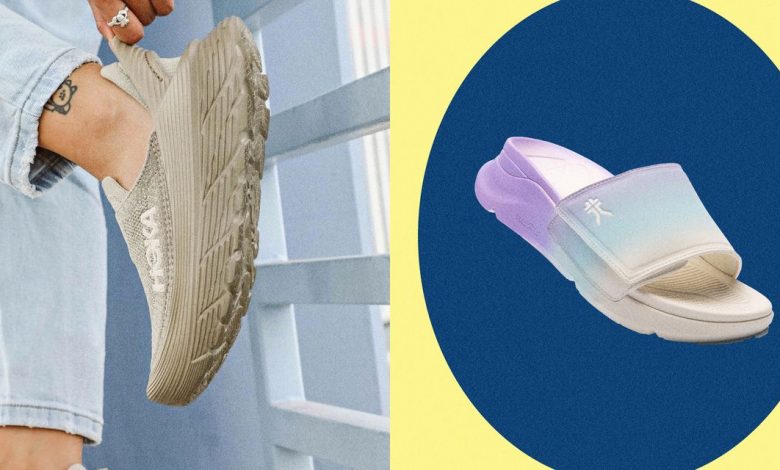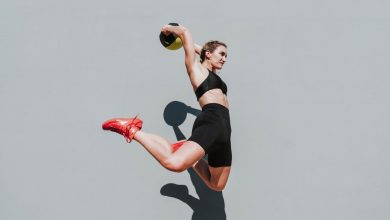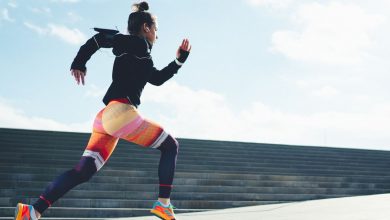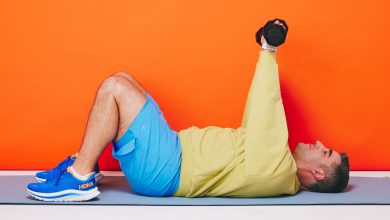The Comfiest Recovery Shoes Make Foot Pain a Thing of the Past

Aside from the breathable, perforated upper, one notable feature of the Revives is the textured footbed that’s designed to increase blood flow to your soles. Although she was initially skeptical about how big of a difference this would actually make, Coughlin found “it has a very subtle, pleasantly kneading effect that engages my feet more than a standard insole, so they feel more ‘awake’ and less fatigued.”
Sizes: 5 to 20 | Weight: 11.8 oz | Heel-to-toe drop: 10 mm
Most Stable: Hoka Restore TC
If it’s too chilly to air your feet out in sandals, this sneak from Hoka at least gives your toes plenty of space. Dr. Glisic points out that the stretchy knit upper and wide toe box lets your tootsies splay out and relax without feeling cramped. When I tried out a pair, I found them plenty roomy, even when my feet were extra-swollen.
What I love most is how stable I feel inside them. The extra arch support keeps my feet from rolling in as I walk, and the super-wide base at the heel makes my foot feel supported from all angles even when it’s extra tired. I also appreciate that these are a cinch to slip on and off when I’m too sore to bend over, but still want a closed-heel design for easier walking.
Sizes: 5 to 15 | Weight: 11.3 oz | Heel-to-toe drop: 5 mm
Best for Hikers: Teva ReEmber Terrain Slip-On
Teva
ReEmber Terrain Slip-Ons
These slip-ons are ideal for giving your tired feet some love while hanging around a campsite at the end of a long day of hiking. The sole is grippy enough to handle wet, muddy surfaces, while the water-resistant, quilted upper will keep your feet remarkably cozy and dry. There’s even an extra loop next to the arch, so you can attach them to the outside of a backpack with a carabiner.
Personally, I especially appreciate just how soft the insole is. It’s so squishy, you feel like you’re stepping on a bed of memory foam. However, I’ve found these clogs are better for walking, say, from the fire pit to the tent, rather than trying to travel any real distance. They’re on the roomy side even with thick socks, so my toes need to grip to keep them on when I start racking up steps. But as long as I’m not planning to go too far, they feel like supportive sleeping bags for my feet.
Sizes: 5 to 15 | Weight: 8.47 oz | Heel-to-toe drop: N/A
Best for Runners: VKTRY Performance Recovery Clog
VKTRY
Performance Recovery Clog
If you love the boost that a carbon-plated shoe offers when you’re running, why not get a recovery shoe with that same extra oomph? The VKTRY clog, designed by a pedorthist, offers just that. “It has a carbon fiber plate built into it, so it really can help propel you forward, removing a lot of the work of those fatigued muscles,” Dr. Sharkey says.
She appreciates that the design includes a removable strap that you can slip over your heel for a more secure fit. Also helpful: the rocker bottom, extra arch support, and deep heel cup are all designed to make sure your feet and calves have to do as little work as possible to keep you upright. Bye-bye, fatigue.
Sizes: 4 to 17 | Weight: 9.8 oz | Heel-to-toe drop: 0 mm
Best for Home: Topo Athletic Revive
Slipping into these clogs feels like giving my feet a spa treatment. The soft fleece upper keeps my feet nice and warm, and the shoe is cozy enough that I don’t mind wearing them even while sitting on the couch. But unlike your everyday house shoe, this pair has arch support that’s designed with a subtle, gradual curve. Plus, squishy pods in the footbed give my soles some extra love.
If I do end up puttering around more than lounging around, the grippy lugs on the bottom of the sole make sure I stay upright, no matter how tired my legs are. I’d just recommend ordering one size up, since my heels come right up to the back edge and would be a little comfier with a smidge more room.
Sizes: 6 to 12 | Weight: 6.5 oz | Heel-to-toe drop: 3 mm
Best Splurge: Oofos Oomy Zen
Whenever her clients are on the hunt for recovery shoes, Dr. Glisic says Oofos is a go-to rec—the brand has the American Podiatric Medical Association’s (APMA) seal of acceptance for healthy footwear. Dr. Glisic likes the Oomy Zen sneaker in particular because it’s equally cushy and supportive. It has more of Oofos’ signature foam than any of the brand’s other shoes, while the foot-cradling design hugs your arch and heel.
When SELF contributor Lauren Wingenroth tried out a pair, she was instantly sold: “I’ve never felt the sense of immediate relief I had when I put the Oomy Zens on,” she wrote in her review, adding that she loved the feeling so much she made several friends try on the shoes too. She particularly appreciated the shoe’s high arch, roomy toe box, and soft, supportive foam.
Sizes: 5 to 11 | Weight: 12.6 oz | Heel-to-toe drop: 6 mm
Best Firm: Vionic Rejuvenate Recovery Sandal
For patients who find Oofos or other recovery sandals to be too squishy, Dr. Sharkey recommends these firmer slides from Vionic. Like the Oomy Zens, these sandals have the APMA’s seal of acceptance too. “They also have a little bit of a deeper heel cup, so I find that for anyone with balance issues, they feel more supported,” she adds.
Just know that the thick, sturdy design means they’re on the heavier side for slides. But one SELF staffer who tested them out loved the lightly massaging feel of the grooved footbed when her feet were aching. At the same time, she found the top-notch support also made them excellent house shoes any day of the week.
Sizes: 5 to 14 | Weight: 14.08 oz | Heel-to-toe drop: N/A
Best for Cold Weather: Oofos Oocoozie Thermo Mule
Oofos
Oocoozie Thermo Mule
Although recovery sandals might be ideal after a hot, sweaty workout, winter weather calls for a different approach. Enter: Oofos’ insulated mule. When SELF’s fitness and food director Christa Sgobba tried out a pair, she found the foam to be “soft and pillowy” while her toes stayed “nice and toasty.” They were so comfortable, in fact, that although Sgobba initially only thought she’d wear them after long runs, she found herself slipping them on from morning till night.
Johnson, who struggles with a neuroma, swears by her Oofos mules to keep it from acting up. Aside from majorly minimizing the pain, one thing that’s impressed her the most is the shoe’s durability. “The longevity is out of this world,” she says. “I’ve had that pair of clogs, I want to say over five years, and they look great.”
Sizes: 5 to 11 | Weight: 11.6 oz | Heel-to-toe drop: 6 mm
Best for Wide Feet: Kuru Moment
Kuru has a reputation for making exceptionally foot-friendly, feel-good shoes, and this plush recovery slide is no exception. “The Moment is a great option for a house shoe or recovery shoe following a long run,” podiatrist Elizabeth Daughtry, DPM, FACFAS, previously told SELF.
The contoured footbed is designed with a built-in orthotic to minimize foot pain. (The generous 12-millimeter heel-to-toe drop could also be particularly helpful for people dealing with issues like plantar fasciitis or Achilles tendinitis.) Meanwhile, the comfy strap across the top is adjustable, so you can get the fit just right.
Sizes: 5 to 12 | Weight: 7.4 oz | Heel-to-toe drop: 12 mm
What to look for when choosing recovery shoes
Recovery shoes should feel good on your feet, Dworecki says. But aside from the comfort factor, there are a few details to keep in mind when searching for your perfect pair.
Recovery shoes should fit similar to any other shoe, with enough room for your toes to wiggle and a thumbnail’s width of space between your longest toe and the front of the shoe. Planning to wear these after workouts? Check the fit at the end of one. “You wouldn’t want it to be too tight because you may swell post-exercise,” Dr. Sharkey says.
Recovery shoes typically come in sandal, clog, or slip-on sneaker styles. Which you choose is largely up to you (and the weather). Though Dr. Glisic points out that sandals allow the feet to breathe and swell naturally, which can be helpful after a sweaty workout. One word of warning: “If you’re going with a slide, make sure it doesn’t require your toes to grip to keep it on,” she says.
Dr. Sharkey points out that if you’re going to wear your recovery shoes on a pool deck or in a locker room, you want a sole with good traction, so you don’t slip. Also, pay attention to the shape of the sole: Many are designed with a rocker bottom to reduce strain on the forefoot and Achilles Dr. Glisic says, but that shape can be too unstable for people with balance issues.
Some styles (like the Oofos OOahh Slide Sandal) have an exaggerated arch, which can feel great, depending on your foot type. Others—like the Teva ReEmber Terrain Slip-On—you can barely feel. “Not everybody might like how a hefty arch support feels, but other people might actually want it, and it feels really good for them,” Johnson says.
While nearly all recovery shoes feature shock-absorbing foam, the feel can vary. “Some of them are much softer, and others are more firm,” Dr. Sharkey says. She adds there’s not necessarily a bigger benefit to one or the other—it just comes down to personal preference. “If it feels good, then put it on your foot,” Johnson says.
How we picked these recovery shoes
First, I spoke to a podiatrist, physical therapist, and coaches to learn what to look for in a good recovery shoe. Then, I asked for their personal favorites and top recs. I also researched which pairs have significant buzz and long-term loyalty. I tried out a handful firsthand and checked out what the SELF team—which tests all kinds of shoes year-round—thought of others, considering qualities like shock absorption, support, durability, stability, and overall comfort.
Frequently asked questions about recovery shoes
Do recovery shoes actually work?
Yes: The best recovery shoes absorb impact, promote circulation, and give your feet the support they need to truly recover, Dr. Glisic says. “Recovery shoes are specifically designed to offload key structures like the plantar fascia, Achilles tendon, and forefoot. Many also have a rocker-bottom sole that reduces the demand on the calf and ankle with each step,” she says.
Who should wear recovery shoes?
While recovery shoes were initially made for athletes to help their feet and legs bounce back faster after hard training sessions or competitions, they’ve since been adopted by lots of everyday people looking for comfy house shoes too.
“I recommend recovery shoes to anyone who trains regularly, stands a lot for work, or deals with foot, ankle, or knee soreness,” Dr. Glisic says. “They’re also great for postpartum moms, healthcare workers, and people returning from injury—basically anyone whose feet take a daily beating, whether in workouts or life.” Dr. Sharkey adds that she regularly recommends them to patients with plantar fasciitis, high arches, and flat feet.
Related:
- The Best Thick Yoga Mat for Your Achy Wrists and Cranky Knees
- You Can Wear These Cute, Comfy Ryka Shoes Everywhere
- The Best Knee Massagers Are Worth the Splurge
Get more of SELF’s stellar product recommendations delivered right to your inbox (for free!).



